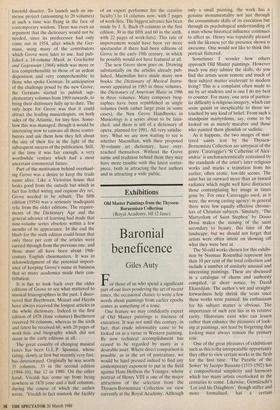Exhibitions
Old Master Paintings from the Thyssen- Bornemisza Collection (Royal Academy, till 12 June)
Baronial beneficence
Giles Auty
For those of us who spend a significant part of our lives pondering the art of recent times, the occasional chance to write a few words about paintings from earlier epochs comes as something of a tonic.
One feature we may confidently expect of Old Master paintings is fineness of execution. It was not until this century, in fact, that crude informality came to be looked on as a virtue in Western painting. By now technical accomplishment has ceased to be regarded by many as a desirable asset. Where direct comparison is possible, as in the art of portraiture, we would be hard pressed indeed to find any contemporary exponent to put in the field against Hans Holbein the Younger; whose portrait of Henry VIII is one of the major attractions of the selection from the Thyssen-Bornemisza Collection on view currently at the Royal Academy. Although only a small painting, the work has a genuine monumentality not just through the consummate skills of its execution but through its psychological understanding of a man whose historical influence continues to affect us. Henry was reputedly pleased with the likeness yet the presence shown is awesome. One would not like to think this portrait flattered.
Sometimes I wonder how others approach Old Master paintings. However much you may admire the skills, do you find the artists seem remote and much of their subject matter irrelevant to modern living? This is a complaint often made to me by art students and is one I do my best to counter. For many, one area of particu- lar difficulty is religious imagery, which can seem quaint or inexplicable to those un- touched by any kind of belief. From such a standpoint martyrdoms, say, come to be looked on as merely macabre and those who painted them ghoulish or sadistic.
As it happens, the two images of mar- tyred saints lent by the Thyssen- Bornemisza Collection are untypical of the genre. Caravaggio's 'St Catherine of Alex- andria' is uncharacteristically restrained by the standards of the artist's later religious works and marks a transition from his earlier, often erotic, low-life scenes. The saint has an outward more than an inward radiance which might well have distracted those contemplating her image in times gone by. For once Caravaggio used, as it were, the wrong casting agency; in general there were few equally effective chronic- lers of Christian subjects. Similarly, 'The Martyrdom of Saint Stephen' by Dosso Dossi makes the stoning of the saint secondary to beauty, this time of the landscape, but we should not forget that artists were often intent on showing off what they were best at.
The 50-odd works chosen for this exhibi- tion by Norman Rosenthal represent less than 10 per cent of the total collection and include a number of similarly unusual and interesting paintings. These are discussed in a catalogue of charm and authority compiled, at short notice, by David Ekserdjian. The author's wit and straight- forwardness help shrink the years since these works were painted; his enthusiasm for his subject matter is obvious. The importance of such zest lies in its relative rarity. Historians exist who can lessen rather than enhance the pleasures of look- ing at paintings, not least by forgetting that looking must always remain the primary role.
One of the great pleasures of exhibitions such as this is the unrepeatable opportunity they offer to view certain works in the flesh for the first time. 'The Parable of the Sower' by Jacopo Bassano (1515-1592) has a compositional simplicity and harmony which too many artists overlooked in the centuries to come. Likewise, Gentileschi's 'Lot and his Daughters', though stiffer and more formalised, has a certain
monumental timelessness. While Bassano owed obvious debts to Titian, Gentileschi to Caravaggio, and Tiepolo (represented by the magnificent 'Death of Sophonisba') to Veronese, each emerges as a distinct and exciting voice.
The lightness and panache of Tiepolo's drawing distances him obviously from the more rounded and solidly sculptural offer- ings of his master. Drawing is the most expressive vehicle of an artist's inner being. Twentieth-century movements which deny drawing diminish true indi- viduality and usually put formal innovation in its place as an inadequate substitute. A great deal of anger has been expended in the past half-century by neglected artists who believe the artefacts made by highly praised contemporaries lie well within their own technical compass. A walk among Old Master paintings encourages a truer per- spective among all.
Whatever the final destination of Baron Thyssen's complete collection, London gains an extra dimension for art-lovers during the next three months by housing what may even prove the hors d'oeuvre to an almost unimaginable feast.



















































 Previous page
Previous page